Posts Tagged ‘Elie Wiesel’
Sunday, March 3rd, 2013
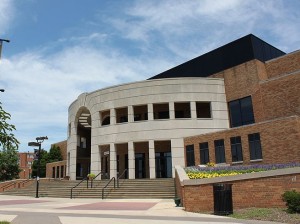 By Carolyn Yeager
By Carolyn Yeager
Kent State President Lester Lefton said the university is expecting thousands of people from across the region to attend on April 11, 2013 when Elie Wiesel speaks as part of the “Presidential Speaker Series.”
The PSS is a project only in it’s second year that “seeks to bring high-profile, world-renowned experts to Kent State for serious, thought-provoking discussions and conversations,” according to the KSU website. But will there be discussion and conversation with Wiesel while he is there? I’m sure not, as Wiesel never takes any questions from an audience (or from anyone anywhere) since so many people have gotten wise to the big fraud he is perpetrating. Wiesel will be whisked in and whisked out through secret passageways with no chance for anyone to interact with him. Expect security to be very tight.
The speech will be given at Kent State’s main campus at 7 pm in the Memorial Athletic and Convocation Center (pictured right), which is located at 1025 Risman Drive, Kent, OH 44242. Detailed directions from all points can be found here. The center has a capacity for 6,327. Assuming an average of $10 per person, that could add up to $63,270. How much of that will Elie Wiesel get?
Wiesel charges a minimum of $25,000 per speech (as of a couple years ago), so those who go gaga over the man’s sentimental words, which are pretty much the same every time, should remember how much he’s being paid to utter them. If you think he ever does anything without getting the highest price the market will bear, you are just misled.
Fifteen hundred free tickets are available now to Kent State students (one ticket per student) on a first-come basis. After the first 1,500 free tickets are gone, Kent State students pay $10 for one ticket and the general admission price of $20 for any additional tickets. It costs $50 for preferred seating (where you can actually see the man). If you buy tickets for a group of 10 or more, the price goes down to $15 per ticket.
What draws Wiesel to Ohio?
It was April of last year, 2012, that Wiesel spoke at Xavier University in Cincinnati, Ohio. A little searching discovered it was sponsored by The Jewish Foundation of Cincinnati with their partners The American Jewish Committee, Cedar Village, Jewish Community Relations Council, The Jewish Federation of Cincinnati, Jewish Vocational Service and the Issac M. Wise Temple. In other words, it was an all-Jewish production.
There is undoubtedly a substantial Jewish community in Ohio that is active and well-organized. They provoke an artificial demand for Elie Wiesel, then much of the non-Jewish population is persuaded it’s a wonderful thing, too. Kent State is making every effort to build an increasingly multi-racial student population – it is evident from browsing through their website.
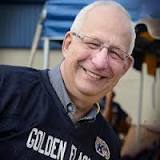 Is KSU President Lefton Jewish?
Is KSU President Lefton Jewish?
It is my opinion that Lester Lefton (left) looks Jewish. Neither on his Wikipedia page, nor on his official Kent State bio page was any religion or family background given – which is highly unusual for an academic and major university president. We’re only told:
Born in Brookline, Massachusetts, Lefton completed his bachelor’s in psychology from Northeastern University in Boston in 1969.
and
Lefton resides in Kent, Ohio with his wife, Linda. They have two grown daughters and three grandsons. Mrs. Lefton is an attorney who served as a state prosecutor in South Carolina and was an academic advisor for pre-law majors at George Washington and Tulane universities
In a news article/PR release from June 21, 2011:
News of a new partnership with Siauliai University brings Kent State’s total number of international connections to approximately 200. That number includes university partnerships, exchange programs, short-term study abroad arrangements and full semester study abroad programs.
This is just one of many indications of the direction President Lefton is taking Kent State. He has also been involved in scandal over his expense account charges to the university.
Between July 2006 and July 2007 Lefton expensed $36,741.93 on entertainment and $44,249.34 on travel.[28] In a Sep 26, 2007 editorial in the Akron Beacon Journal Lefton was criticized for extensive travel to Europe, a portion of which was charged to the University, as well as hiring two additional vice presidents during a time when university tuition and fees increased for students.
Further controversy in 2007 included an agreement to pay $88,000 for a Vice President to pursue a doctorate at Case Western University. This came at a time when the university was raising student tuition and was of further concern because the same degree could be earned at Kent State University.[30]
Unfortunately, links found in footnotes 28, 29 and 30 on Lefton’s Wikipedia page are no long viable; the stories have been removed. The power of Jewish media at work?
Do we have Ohio residents willing to protest Wiesel’s appearance?
If there were a large enough group (five or more) outside the Convocation Center, or at any good campus location in the week prior to Wiesel’s speech, it could be effective. Signs are sufficient; no need to hand out flyers, but some should be available for anyone who asks for it. Two items demand attention at this time:
- The perennial question “Where is Elie’s Tattoo?” “Show the American people your tattoo, Elie!”
- What about the missing standing man in the Buchenwald Lie-beration Photo that Wiesel says he is in? We would like a comment from Wiesel on the photo in the article from the New York Times and the cover of Mel Mermelstein’s book that both show that photograph without the tall, naked man. And what about Mermelstein never mentioning Wiesel in his 1979 book about his internment at Auschwitz and Buchenwald when they were only 2 years apart in age and both were part of the Hungarian deportation in 1944?
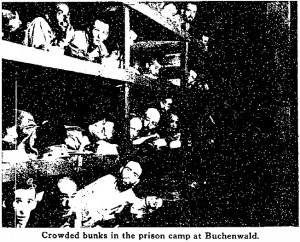 Copying images from this website and getting blow-ups made to paste onto posters seems to me a doable thing. It’s best to start organizing now, contacting others you know in Ohio and especially the Kent, Ohio area. I know Ohio is well-populated with men and women who consider themselves part of the Truth Movement. Heck, even Gordon Duff lives in Ohio and he fashions himself on VT as some kind of “holocaust revisionist.” He should act the part and get out there and challenge Elie Wiesel’s version of history. And remember, you don’t have to be a “holocaust denier” to object to the false testimony of Elie Wiesel! Don’t let anyone get away with labeling you with that. Be brave, and spend some of your valuable time for the truth. This may be the last opportunity you’ll have to protest Elie Wiesel in person before death turns him into an eternal martyr and saint.
Copying images from this website and getting blow-ups made to paste onto posters seems to me a doable thing. It’s best to start organizing now, contacting others you know in Ohio and especially the Kent, Ohio area. I know Ohio is well-populated with men and women who consider themselves part of the Truth Movement. Heck, even Gordon Duff lives in Ohio and he fashions himself on VT as some kind of “holocaust revisionist.” He should act the part and get out there and challenge Elie Wiesel’s version of history. And remember, you don’t have to be a “holocaust denier” to object to the false testimony of Elie Wiesel! Don’t let anyone get away with labeling you with that. Be brave, and spend some of your valuable time for the truth. This may be the last opportunity you’ll have to protest Elie Wiesel in person before death turns him into an eternal martyr and saint.
14 Comments
Category Featured | Tags: Tags: Buchenwald Lie-beration photo, Elie Wiesel, Kent State University, Mel Mermelstein, missing standing man, Pres. Lester Lefton, protest, Where is Elie's Tattoo?,
Social Networks: Facebook, Twitter, Google Bookmarks, del.icio.us, StumbleUpon, Digg, Reddit, Posterous.
Friday, January 4th, 2013
By Carolyn Yeager
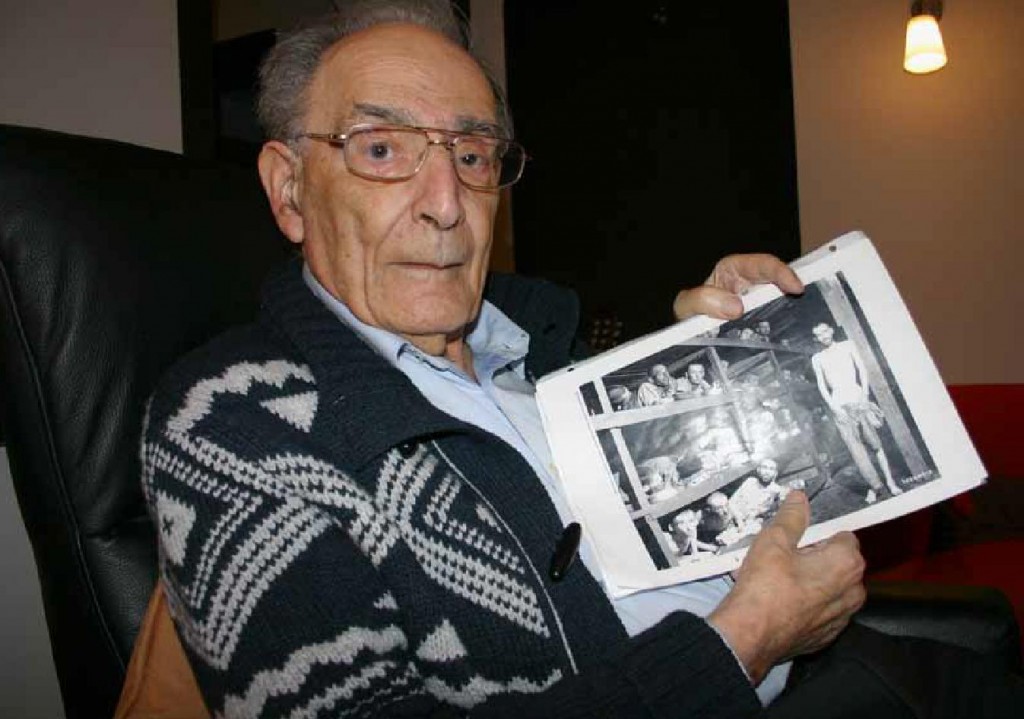
Max Hamburger, a Jewish-Dutch psychiatrist, is the man in the above photograph taken in 2012. He is 92 years of age.
Hamburger has identified himself as the fourth figure in the bottom row of the famous Buchenwald photo — the figure he is pointing to with his thumb. He was 25 years-old in April 1945 when the camp was “liberated” by American troops. I want you to notice right away the space between Hamburger’s nose and upper lip — it is unusually long. The face of the young man in the famous photo does not have that long space, but just a normal, or even short, distance between nose and mouth. This is facial structure that doesn’t change, which is one clue that tells me he is not the same person.
Born on February 10, 1920 in Amsterdam, Max began the study of medicine in 1938 and, as best I can make out from Dutch language sources, he was arrested in 1942 because of his activism in the Dutch Resistance and sent to Westerbork, a camp for political prisoners in The Netherlands. He ended up in Auschwitz and then Buchenwald, he says, taking the usual route. According to this page, he was suffering from TB, and also malnutrition, when the famous photo he’s holding in his hands was taken.
The blurb on the Flicker page also says “he only survived Auschwitz because he could work as a medical assistant.” One has to ask about all those who didn’t work as a medical assistant, but also survived and went to Buchenwald … and survived Buchenwald too without being medical assistants! This is the kind of meaningless tripe we are always given to explain why people survived “death camps.” This page also says he now (in 2008) lives in Belgium and gives talks about his wartime experiences. In other words, he advertises himself as a holocaust survivor who is in the Famous Buchenwald Liberation Photo, the one that Elie Wiesel is in. (See final section below)
It should be noted that Nicholas Grüner is in this photo too; he is the first person on the left in the bottom row and the only one of the three mentioned who actually looks like himself, and is himself. Yet the labeling of this photograph at Yad Vashem Holocaust Memorial in Jerusalem (below) gives three possible identities for this figure: Gershon Blonder, Josef Reich or Nicholas (Miklos) Grüner … as if it were in doubt. The other two are not shown to be in doubt: the fourth figure on the bottom is Max Hamburger; the seventh figure in the 2nd row is Elie Wiesel. It’s clear to me that Yad Vashem will eventually deny that Nicholas Grüner is in the photo at all, and thus his claim that Elie Wiesel was not in the camp (or the photo) will be weakened. These people are nothing if not devious … and they accomplish their objective in a gradual manner. According to Yad Vashem …
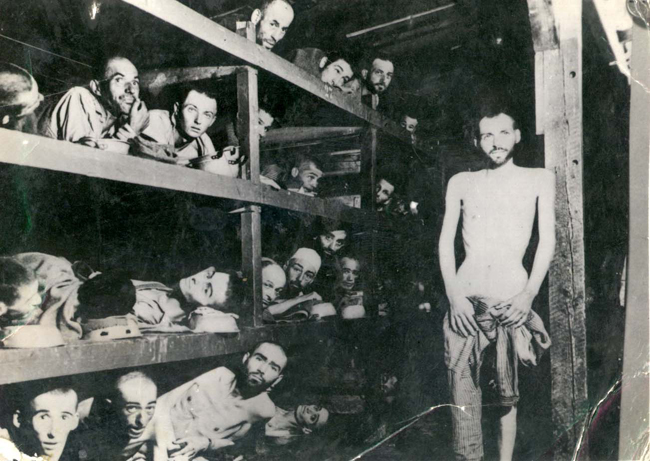 Second bunk:
Second bunk:
First from right– Elie Wiesel
Fourth from right:
• Herman Leefsma or
• Abraham Hipler or
• Berek Rosencajg or
• Zoltan Gergely
Fifth from right:
• Lajos Vartenberg (Yehuda Doron) or
• Yaakov Marton
Bottom bunk:
First from right – Max Hamburger
Third from right – Issac Reich
Fourth from right:
• Michael Miklos Nikolas Gruener or
• Gershon Blonder or
• Yosef Reich
Standing on the right: Chaim David Halberstam
Also notice that on the Flicker page the third man from left in the 2nd row up is not identified. That page went up in 2008. But on the Yad Vashem non-linkable “Anonymous No Longer” page for this particular photograph, this man is given two possible identities: Lajos Vartenburg (Yehuda Doron) or Yaakov Marton. On another Yad Vashem page with this picture, it reads:
On the second bunk from the bottom, third from left is Losh Wertenberg who later changed his name to Yehuda Doron, and according to other identification this man is Jeno Marton (identified by Yaakov Marton).
Screwy. Yad Vashem accepts whatever is sent to them because the memorial is by, for and about the Jewish people and they can do no wrong. However, we, of more discriminating nature, have to doubt that any of these names are correct … except Grüner.
Does Max Hamburger have a valid claim to be “the zombie” in the photograph?
It’s important to remember that this photo is recorded as having been taken on April 16, five days after the actual liberation. If this 4th person in the lower bunk had TB, would he still be lying in this barracks 5 days later or would he be in a hospital? If this were a hospital barracks, why do some of the men look so healthy? Elie Wiesel did not have TB, but, according to his own accounts, two days after liberation he ended up unconscious in the SS hospital with severe food poisoning. So Wiesel couldn’t be in this picture by his own statements!
Nicholas Grüner also had tuberculosis (TB) when this photo was taken. However, Grüner seems to think it was on the day of liberation, April 11, because he writes in his book Stolen Identity that as they were being marched to the camp entrance on that day (believing they were being taken somewhere to be killed), he managed to leave the line and run into the nearest barracks and jump into an empty bunk — which was this one. Later an American soldier came in and took a picture. Grüner was only 16 and had been living in the special children’s barracks, the same that Elie Wiesel says he was in. Grüner says his TB was not diagnosed until he was fully processed and he was then sent to a sanatorium in Switzerland, where he recovered.
I do not know if Max Hamburger has told a story about how his TB was treated. My information on him comes only from these few sources, mostly in the Dutch language. (Anyone who is able to translate the pdf article, please contact me.)
If Max Hamburger is the fourth man on the bottom row, he must also be the third man in the next row up (2nd row) because they are the same man. Yet he doesn’t say that — so something is very wrong with his claim.
Facial comparison of the two men
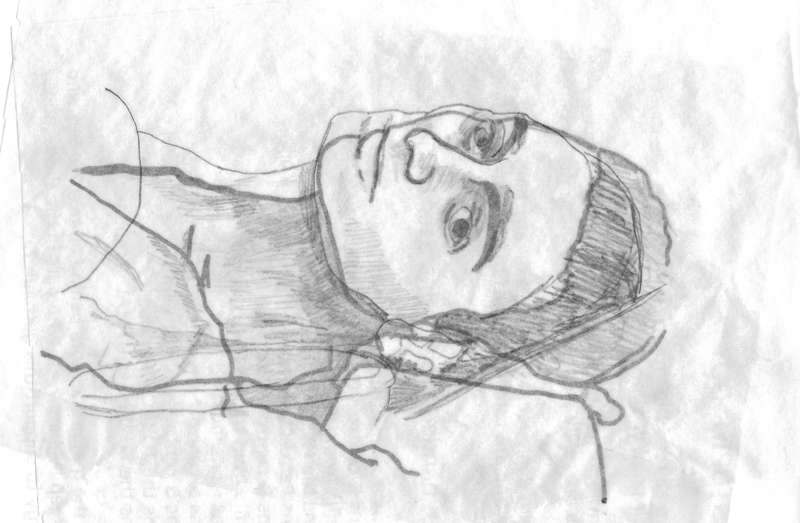
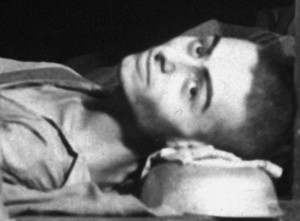
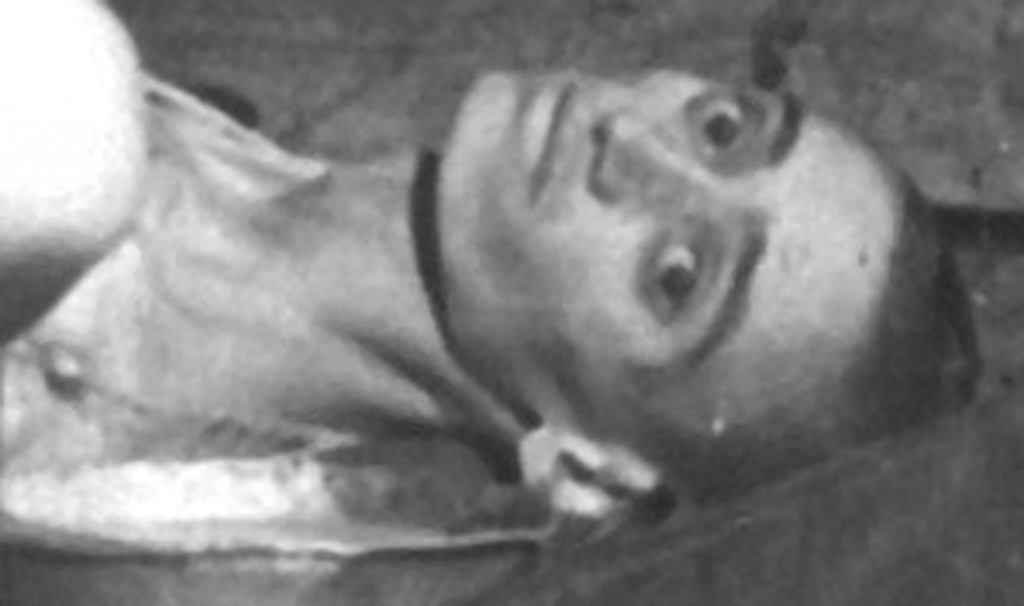
After printing the largest images of the two men’s faces, I did a careful tracing of each one. I then overlaid one on the other (in the drawing above) and determined:
- The nose, eyes and eyebrows, and head lined up perfectly one with another. This would not be possible if the two faces were not the same person.
- The mouth, while also remaining identical, is shifted upward on the “zombie” (as you look at the photo) and the entire lower face is widened and the jaw squared off. I’m not sure how this was accomplished, but on this particular figure it seems to be retouching paint. Look at that cauliflower ear, for example! The head is re-situated as laying flat on the bunk board (from the original pose of being propped up a few inches), necessitating a change in the relationship to the neck.
I thickened the outline of the “original” so it’s easy to tell which is which. You can compare the small photographic images of the two faces (left: 2nd row; right: bottom row) with the overlay to see how the very poor “retouching” job was done. Talk about sloppy work!
Why not just use a different person?
Why would they decide to insert the same man and then have to go to such lengths to make him look different? I think the answer to that is: several shots of this scene (with fewer live bodies than are there now) were taken on April 16, and only later it was decided to “fill in” the empty bunks by inserting figures from other negatives. For example, the two heads on the far left in the second and third row are clearly the same man with a slightly different twist of his head. The sleeping man, second from left in the second row, may be another view of the two men on the far left! Because why isn’t he facing the camera like all the others? The standing man is also a later addition inserted onto the photograph (see here).
As I pointed out before, this “Zombie copy” was also not gauged correctly size-wise — he is noticeably smaller than the men in the bunk right above his, when they should match up according to the laws of perspective.
More on Max Hamburger
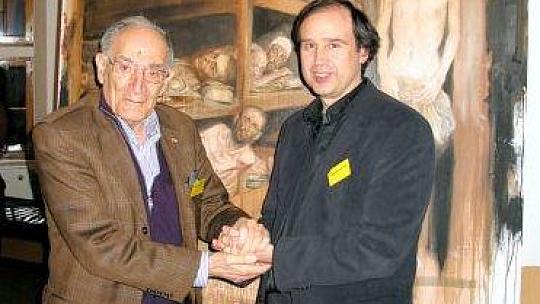 He is the son of a Dutch diamond polisher and baseball player, Hartog Hamburger. During a competition game in 1924, Hartog was hit on the head by a line drive when in the field. He died the next day as a result of the impact.
He is the son of a Dutch diamond polisher and baseball player, Hartog Hamburger. During a competition game in 1924, Hartog was hit on the head by a line drive when in the field. He died the next day as a result of the impact.
In February 2010, Max participated in the panel discussion of the Aachen Rabbi Mordechai drill in the German city of Aachen, along with the artist Máro and several others.
Both Máro (right) and his painting are shown in photo above, with Hamburger (left). According to the German news account:
“The discussion was all about the [then] 90-year-old Holocaust survivor Max Hamburger, whose speeches have gained great respect and […] the painting shown in the Castle Gallery by Máro, the image of a scene from the Buchenwald concentration camp.
“The artist explained the reasons which led him to the theme of the sufferings of Auschwitz. The series of pictures, which deals with the darkest chapter of German history, are meant to generate compassion and sensitivity for the suffering of the people depicted. […] Besides the issue of the Holocaust was also the art world itself, and the responsibility of the artist to contribute to the discussion of the Nazi terror, [which was] the focus of the [panel] discussion.”
4 Comments
Category Featured | Tags: Tags: artist Máro, Auschwitz, Buchenwald liberation photo, Elie Wiesel, Max Hamburger, Nicholas Gruner, Yad Vashem Memorial Museum, Yehuda Doron,
Social Networks: Facebook, Twitter, Google Bookmarks, del.icio.us, StumbleUpon, Digg, Reddit, Posterous.
Sunday, December 23rd, 2012
By Carolyn Yeager
copyright 2012 carolyn yeager
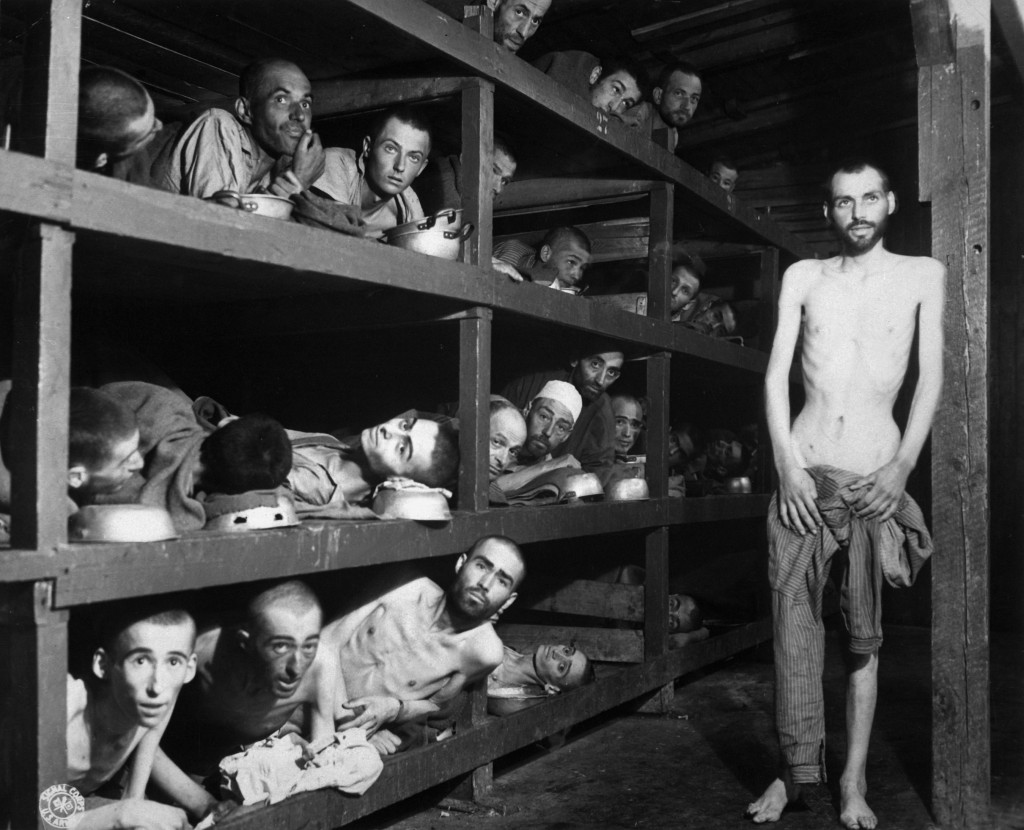
Do you remember the nursery rhyme that goes:
Sugar and Spice and all things nice, that’s what little girls are made of.
How about this one:
Magic and Trickery and all things fakery, that’s what “the holocaust” is made of.
This very famous image associated with the so-called “Holocaust” that was discussed in the previous post has turned out to be fraught with fakery. A sharp-eyed reader, Paul Borresen, noticed something that, once seen, makes one wonder how it was not seen before!
What he noticed is that, in addition to the forged standing man exposed in my previous post, one of the men in the bunks appears twice in this Famous Buchenwald Lie-beration Photo, and the similarity is unmistakeable.
Viewing the photo above, enlarged as much as it can be … find the young man lying on his back with head turned toward the photographer, in the 2nd row up from the bottom, 3rd from the left. His head is resting on his food bowl. (close-up on left, below, designated ‘Original’)
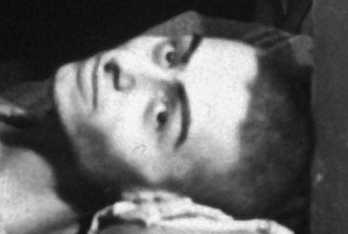
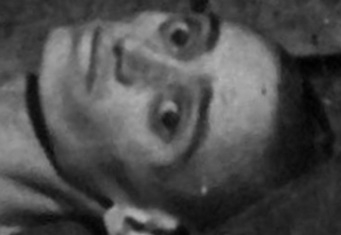
Now look at the young man in the same position in the bottom row, 4th from the left. He is the same man! (close-up on right, above, designated ‘Copy’) The food bowl has been removed from underneath his head, leaving it to a military intelligence photo-retoucher to redo his throat and neck, but in a very un-anatomical manner. Have you ever seen a neck that looked like that? I have not. In an attempt to retain a lesser portion of the ‘gown’ he was wearing so that it would not look the same as the ‘original,’ more bare skin is left showing, but without any anatomical correctness whatsoever.
The retoucher was not a trained artist and was in over his/her head with this assignment. For example, look at the ear. It consists of a few strokes of light-colored paint in an attempt to make something resembling an ear, but failing. Ears are one of the most difficult parts of the body to draw or paint in a convincing manner, but it was necessary to add an ear to this ‘copy’ because the ear is not showing on the original man in the bunk above; it is buried against the upside-down food bowl and some material that’s covering it. The botched ear of the ‘copy’ is one of the biggest giveaways of fakery in this photo, but not the only one.
What’s with all these thick, black eyebrows?
Let’s look at the eyes and eyebrows next. The man whom we are calling “the original,” has very dark, thick eyebrows but otherwise looks normal. The shadow under his chin is probably what was actually there – bringing attention to the fact that a very bright light source in a dark room was shining on the men, and hitting the lower two rows of bunks more than the upper two rows. His “copy” also has very dark, flat eyebrows but they have been redrawn to begin higher up from the bridge of the nose and extend down to the outside corner of the eye, giving him a wild look. Adding to this wild-eyed look is the delineation of more distinct eyelids, rounding the eyes and enlarging the irises, all of which create the zombie look which the ‘original’ doesn’t have.
A couple more things were done in a futile effort to camouflage this ‘copy’: the rounding of the forehead, head, and hairline, and the squaring of the chin and lower jaw. A crude line of black paint, applied all the way up to the big, white ‘cauliflower’ ear, was evidently thought to suffice for a shadow under chin and jaw. Look closely especially where it meets the ear and you can recognize it is paint.
Yet, the nose, mouth, upper jaw and facial shadows remain exactly the same in both figures. The result is a grotesque second person that I suppose has been eliciting sympathy from clueless viewers all these years.
This grotesque, over-worked ‘copy’ is also smaller than it should be for the bunk it occupies – actually being the same size as the man peering out from the next bunk further down. Maybe the forgers thought this would make him look like a young boy. If so, they failed to realize that boys don’t have tiny heads! Now, this peering man has clearly had his eyebrows and eyes emphasized with black paint or pencil. Or he may be totally fake. Others whose eyebrows were treated similarly are: The “elie wiesel” face has heavily emphasized eyebrows; also the second and third man in the third row, and all the men in the top row. I believe the best explanation for this phenomenon is this: the poorly painted eyebrows of the ‘copy’ would stand out too much from the natural-looking eyebrows of all the rest, so it was decided to give a swipe of black paint to many other eyebrows also, including our ‘original.’
As a practicing artist most of my life, from childhood on, who has drawn and painted hundreds of faces and done many portraits, I know quite well how to touch up faces and how tiny adjustments can make a big difference in attaining a likeness. The assignment here was to do the opposite of attaining a likeness; it was to take a photographic carbon copy and make it look unlike the original. If I had done the work on this photograph it would be far superior to the image we have, which is a really sloppy job by people who are not artists and therefore don’t have “an eye” for how things actually look and/or don’t know how to make it look that way. Which is a good thing for us!
NEW ENLARGED IMAGES! In these close-ups showing more of the neck and the space around the faces. we can see more clearly how the head of the “copy” in the lower bunk is angled back, just slightly, since he is lying with his head directly on the floor of the bunk, not propped up as is the “original.” I think it’s likely that after altering the face and hair, and adding an “ear,” the forgers severed the face/head at the jawline and proceeded to paint a brand new neck that would fit the newly angled face with the slightly raised chin. This is why everything below the chin is so horribly wrong. We can see a collar bone and shoulder in the ‘original,’ but there is no bone structure at all in the ‘copy.’ The crude black line representing a shadow under the chin serves to “attach” the two parts together.
The ‘copy’ also has far less contrast, is overall grayish, which would happen from all the retouching, or also that this copy was set for low contrast. We can see that the shadows on the side of the face follow the same pattern even though they’ve been interrupted here and there. We can also see clearly how the upper line of the face was indented right below the cheekbone, and was added to along the mouth area. The line of the mouth between the upper and lower lips goes all the way to the edge of the face, but on the ‘copy’ it stops short of the edge. You can see the gray paint added at that upper corner of the mouth.
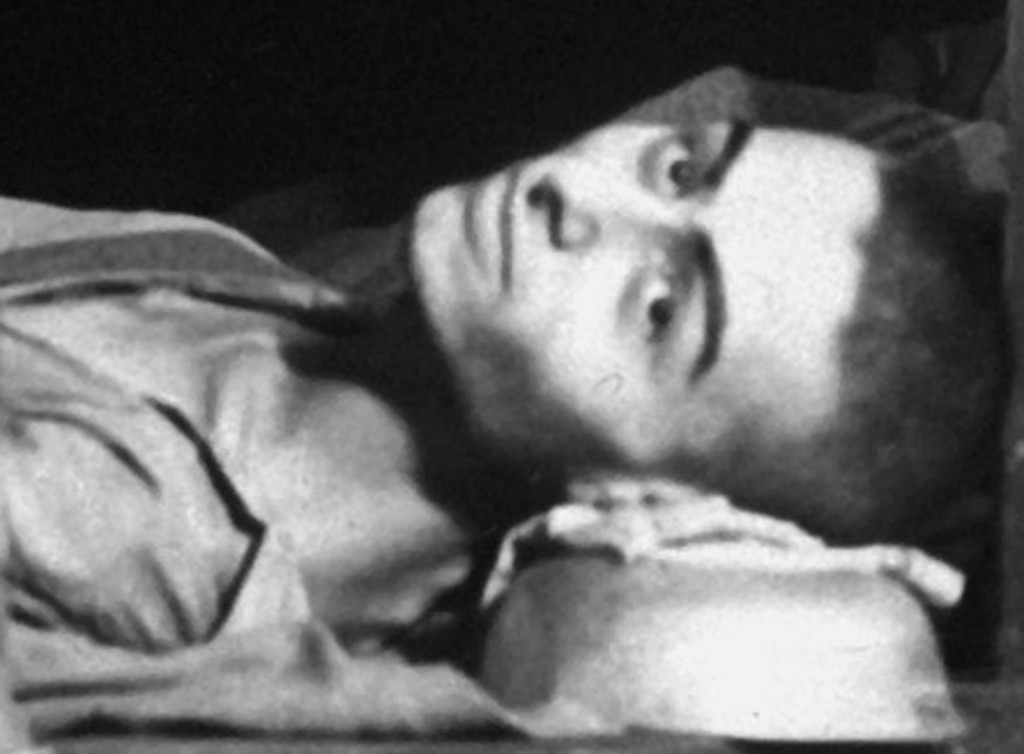

Hundreds of forged and mislabeled photographs make up the “Holocaust”
This is one photograph out of many that were also forged. I believe it is one of the most important because it has been given such a prominent place among the documents “proving” the “Holocaust.” Elie Wiesel, or his handlers, no doubt selected this photo – from many possible others wherein he could be falsely identified as one of the crowd – because it was already so well-known and was in many books and publications. Therefore, whenever it is published somewhere, it can be said that Nobel Prize winner Elie Wiesel is in the picture. However, they didn’t count on it being exposed as a fraud – they never do. But now it has been, and it’s up to us – all of you reading this – to see that the exposé becomes known everywhere this photograph appears. This is what it will take to break the spell.
What we have to fight against – our own people
A fellow revisionist who helps me with technical issues from time to time for this blog actually wanted me to hold back on this because he could not be sure that the two figures discussed in this article are the same man! What would it take to convince him? A confession from the perpetrators? A corroboration from an authority figure or a Jew? Why the difficulty in contradicting the given narrative?
A poster at Stormfront who boldly calls himself “The Hammer of God” had this to say when confronted with the empty black area in the NYTimes reprint:
Idk, newspapers did have pretty low-quality pictures at that time, so maybe that whole area was just set to black, but it looks bright enough for that person to have shown up. The lighting actually seems a bit brighter on that man, which makes it even stranger why that section would appear black. So, perhaps it is a forgery, but I can’t say for certain.
People like ‘The Hammer” should spend more time studying how the magic spell works. It works like this: Evidence doesn’t count; don’t trust it; don’t trust your own brain; trust the consensus. Far too many of us cannot break out of the consensus about the “Holocaust” and the ” evil Nazis.” For this reason, we need to clearly understand what is being done, and how it’s being done. The “how” is very important. It’s a kind of sleight of hand, a magic act, and we are the ones being both entertained and kept in servitude by it. Understanding this is how we will break the spell.
7 Comments
Category Featured | Tags: Tags: Elie Wiesel, fakery, famous Buchenwald photo, Holocaust, magic, photo retouching, trickery,
Social Networks: Facebook, Twitter, Google Bookmarks, del.icio.us, StumbleUpon, Digg, Reddit, Posterous.
Wednesday, December 19th, 2012
By Carolyn Yeager
copyright 2012 carolyn yeager

This is the photograph that Allied Supreme Commander General Dwight David Eisenhower ordered, in April 1945, to be posted in every German town and city 1 to show the defeated population the “true meaning of Nazism.”
Was this photo made to order according to Ike’s specifications?
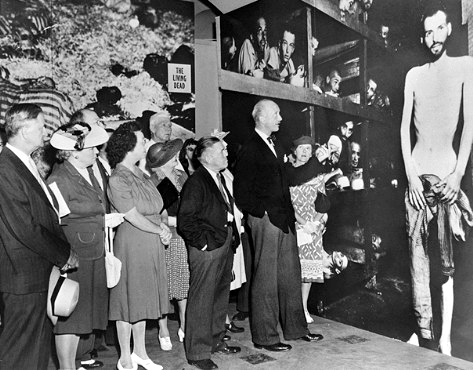 A huge blown-up version then went on tour in the United States for the same purpose, to impress on the American people what evil they had gone to war against; why the sacrifice of blood and treasure was justified! Left: “A traveling exhibit of larger than life size photographs was first shown in St. Louis, MO in summer 1945 and then taken to Washington, DC.
A huge blown-up version then went on tour in the United States for the same purpose, to impress on the American people what evil they had gone to war against; why the sacrifice of blood and treasure was justified! Left: “A traveling exhibit of larger than life size photographs was first shown in St. Louis, MO in summer 1945 and then taken to Washington, DC.
It was plastered on the front pages of newspapers across the country. Thus it became one of the most iconic images representing WWII and of what later came to be known as “The Holocaust.” The intention was to portray the war as a noble effort to “save the Jews from enslavement and extermination,” just as the equally bloody American Civil War had come to be taught as a war “to free the slaves,” i.e. the Negroes who were not citizens of the country they were living in.
Both are black propaganda campaigns that still use whatever is at hand, whether it be subterfuge or not.
In the case of the above photograph, we have learned that the standing figure, the part that makes the biggest, most memorable impact on the viewer, was added later – it was not in the original photo allegedly taken by Private H. Miller of the Civil Affairs Branch of the U.S. Army Signal Corps on April 16, 1945, five days after the “liberation” of the Buchenwald Concentration Camp by American forces.
A blogger, the owner of the Winston Smith Ministry of Truth website who goes by the nickname Black Rabbit, decided a week or so ago, out of curiosity, to order the New York Times newspaper article from May 6, 1945 in which this photo was published, and when it came the photo looked like this:
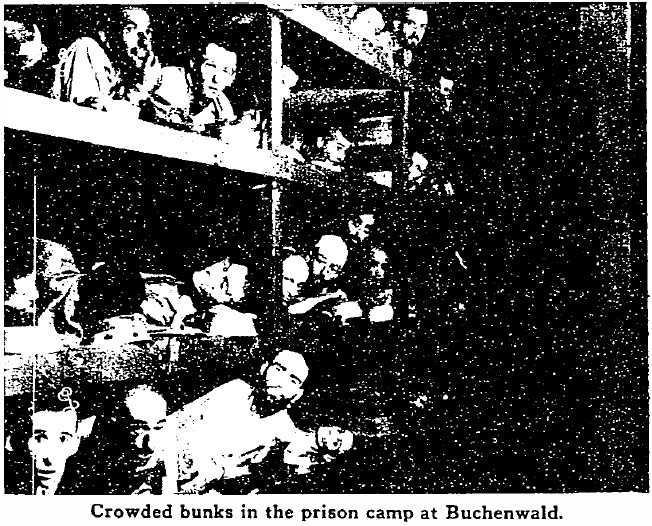
Here is page 2 and 3 of the New York Times article (click to show entire page):
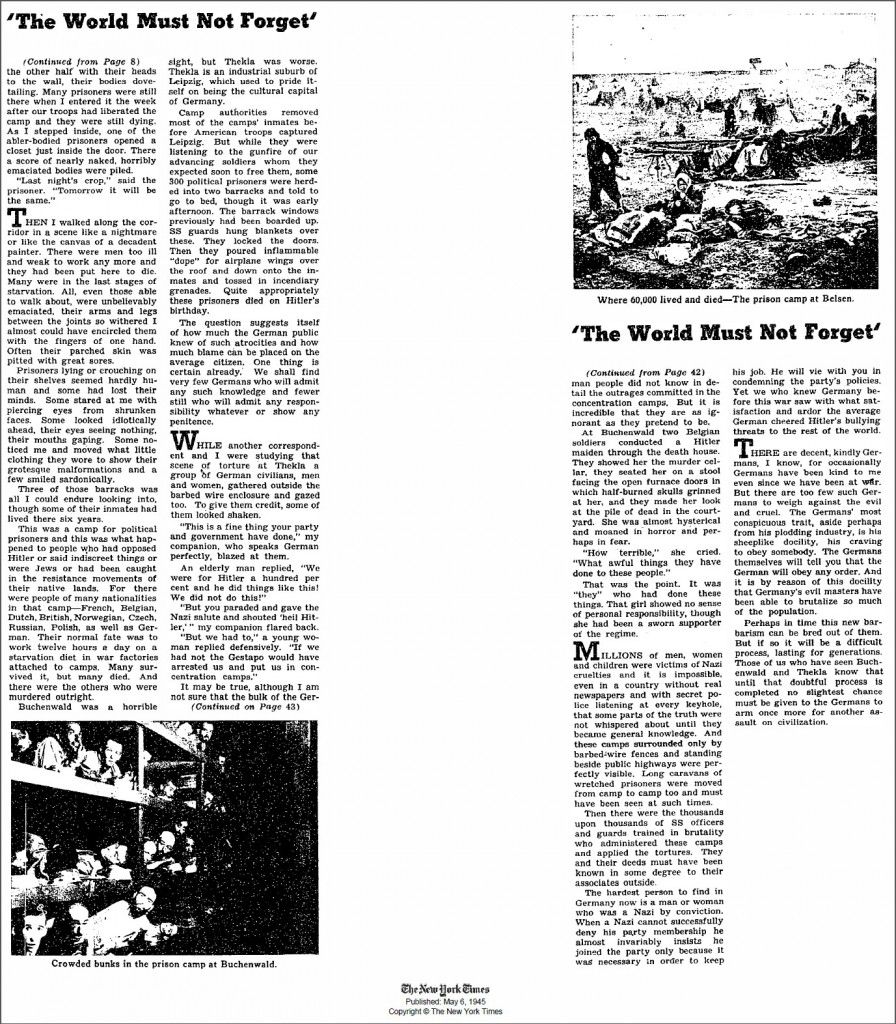
What a shock to see only an empty dark space, and in the New York Times no less!
What happened to the standing man? I was the first to bring it to the attention of the participants in the comment section of furtherglory’s Scrapbookpages Blog after Black Rabbit posted a link to the original article there, and then we quickly began noticing the tell-tale signs of FORGERY about this strange figure who had always appeared odd to me standing there naked as he is, but did not arouse enough suspicion amidst all of the onslaught of “holocaust” imagery, stories and news articles with which we are constantly being bombarded. We see what we are supposed to see, what we’re told we’re seeing, and almost always leave it at that. It is also one of the better photo-forgery jobs of Allied holocaust black propaganda – could that be because it was being done at the behest of the Supreme Commander himself?
But let me point out some problems with this figure:
- His position in relation to the post is an impossible one (see top photo; click once on image and then again for full enlargement). He is not leaning against the post, but neither is he standing in front of the post. His feet are in line with the base of the post, but his left shoulder and arm are in front of the post – without any shadow of any kind. There is something ghostly about this figure, as though he’s an apparition.
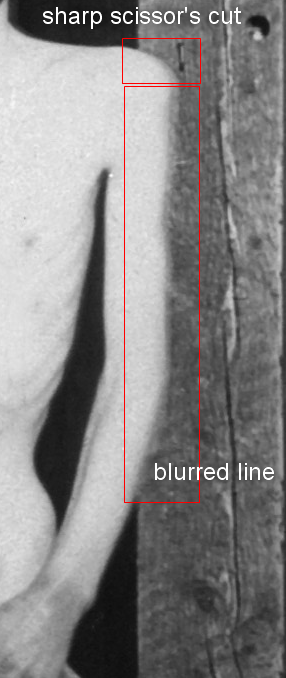 The edge of his left arm is fuzzy, as if it is drawn or painted where it meets the post (detail right). The rest of the outline of his shoulders and arms is very sharp, as though cut with scissors. [In most large-scale reproductions of this photo we have seen (as shown on the Winston Smith Blog), the left edge of the arm is cropped because the larger the image the more noticeable it is.
The edge of his left arm is fuzzy, as if it is drawn or painted where it meets the post (detail right). The rest of the outline of his shoulders and arms is very sharp, as though cut with scissors. [In most large-scale reproductions of this photo we have seen (as shown on the Winston Smith Blog), the left edge of the arm is cropped because the larger the image the more noticeable it is.- Notice the blinding whiteness of his torso, and how different it is from his face, hands and legs which are darker (top photo again). The more one studies the torso and arms, the more they look like a drawing rather than a photograph. Notice how faint are the nipples and definition on his chest compared to the man in the lower bunk who is pushing himself forward the better to be seen.
- Notice the relaxed, almost dreamy expression on the face of the standing man (detail below): his lips are parted in a smile; his eyes are looking off into the distance, not at the photographer. He appears in an untroubled state of mind, unsuited to the environment he’s in and unlike the other men .

- 5. A light source seems to be coming from above right as we face the photo, but the shadows on the legs and feet suggest a light source directly from above. Also, the angle of the shadows on the floor made by the post and by the right leg of the standing figure are not aligned.
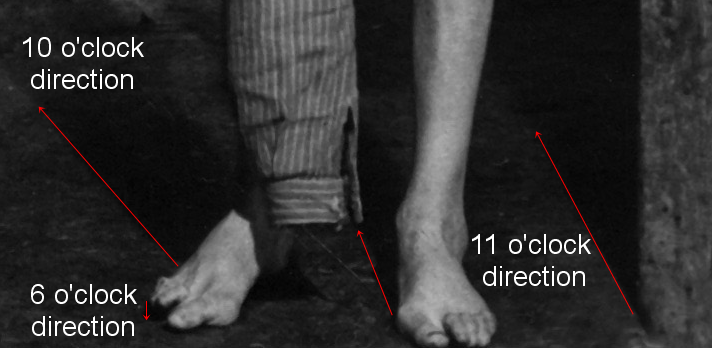
6. Ask yourself why he would be standing there completely nude, with that unlikely expression on his face, five days after the liberation? Also ask yourself why these men would still be lying in these bunks fully dressed, though some having taken their shirts off for effect, five days after the liberation? The only answer is that it’s a staged, arranged photo-shoot for propaganda purposes, not an impromptu entry by a photographer right at the time of liberation – as we are led to believe (because we are supposed to believe it) by the captions that accompany the photo. For example, in the Moberly (Missouri) Monitor-Index on April 30, 1945, the caption to this photo reads: “Slave laborers in their crowded rough bunks in the Buchenwald concentration camp near Jena, Germany, as they were found when U.S. troops of the 80th Division entered the camp.”
Fakery such as this is common in war propaganda; it just usually doesn’t last so long
We not only have the NYT newspaper article showing the photograph without the standing man, but we can also point out tell-tale signs that this figure was added to the photo … and that it was itself doctored to show a very skinny torso of a “starving” man. What deceit! If Eisenhower propaganda specialists had really found such scenes, they would not have had to invent them!
And yes, I’m asking how many personnel were aware, had to be aware, of this type of forgery. And some still living who are still perfectly aware that “The Holocaust” was and is a post-war intelligence operation with no holds barred. For example, so many of the photos that are archived and sold to the gullible public by the propaganda mill that goes by the name of the United States Holocaust Memorial Museum (USHMM) (using your tax dollars) are wildly mislabeled. The USHMM identifies this very photograph as follows:
Former prisoners of the “little camp” in Buchenwald stare out from the wooden bunks in which they slept three to a “bed.” [Photograph #74607]
Elie Wiesel is pictured in the second row of bunks, seventh from the left, next to the vertical beam.
The man in the bottom left hand corner has been identified as Michael Nikolas Gruner, originally from Hungary, Gershon Blonder Kleinman or Yosef Reich. Isaac Reich is in the bottom row, second from the right and Max Hamburger is on the bottom row, fourth from the left. Perry Shulman from Klimitov, Poland is on the top bunk, second from the left (looking up). The man in the second row, third from left has been identified as Dawid Najman. The man in the second row, fourth from the left has been identified as Abraham Hipler; Berek Rosencajg from Lodz or Zoltan Gergely from Cluj. The man on the third bunk from the bottom, third from the left, has been identified as Ignacz (Isaac) Berkovicz, Abraham Baruch and Paul Argiewicz . Juraj (now Naftali) Furst is pictured in the third bunk, fifth from the left. Standing on the right is Chaim David Halberstam.
Others say the standing man is Simon Toncman, who after the ‘Liberation’ returned to his home country The Netherlands, started a family and became a successful businessman. He refused to talk about this photo until the day he died. 2 (Why would that be? Because he knew it was a fake! And because he had been told to keep quiet about it. That’s the best, and only reasonable explanation.)
Of the identified men, one is definitely mis-identified! — and that is Paul Argiewicz. The real Paul Argiewicz was discovered by furtherglory; I picked up his work here (scrowl down to the German drivers license). How could the “Jewish Organizations” with access to Bad Arolson get that so wrong? They all do it all the time. For example, the ‘meantime -Allen Hall” article says that “Red Cross records show Heiman Leefsma survived Barrack 56 as a 20-year-old.” Yet when we see who he is identified as in the Flicker picture, he has a balding head and looks like the oldest man there.
And then there is Elie Wiesel! Please see especially here for proof that the man in the bunk is NOT Elie Wiesel. So that is more fakery surrounding this photo, but in this case the person was really in the original photograph, but is an unknown person. The decision to call that man Elie Wiesel was only made around 1983, with a Nobel Prize in mind.
Both the USHMM and the Allan Hall article are full of errors. There is no need for holocaust “historians,” filmmakers, or “researchers” to be concerned about accuracy — it doesn’t matter how iconic or world-famous they are. Sloppiness goes unpunished, especially since so much of it is on purpose — to deceive and keep the myth going. I will be posting about some other fraudulent pictures from Buchenwald in the future.
End Notes:
1. “US army commander General Dwight Eisenhower ordered this picture to be posted in every German town and city to show the defeated population the true meaning of Nazism,” writes Allan Hall. http://www.meantime.com.au/mean-time-articles/2008/8/12/60-years-on-the-faces-of-nazi-shame-get-their-names-back/
2. Same source (meantime.com): Quote – “Now, 63 years after they were liberated, they have been united again in print by a German newspaper granted rare access to the files of the Red Cross Tracing Service at Bad Arolsen, Germany.
Using the original German SS registration cards and the camp’s “Todesbuch” – book of death – researchers were able to match up names with Jewish organisations around the globe.
Paul Argiewicz, 82, is now living in the US. He lost his parents in the gas chambers and is a regular on American TV shows talking about his experiences.
Red Cross records show Heiman Leefsma survived Barrack 56 as a 20-year-old. A Dutch national, he vanished shortly after liberation and inmate 130305 has not been heard from since.
Nikolas Gruener, now 80, is a Hungarian Jew who was suffering from TB at the time of liberation. “We warmed ourselves on the bodies of the dead before they cooled down,” he said. A successful businessman after the war, he took part in a number of interviews recently for director Steven Spielberg’s Holocaust archive. He lost his parents and two brothers in the camps.
Max Hamburger is now 88. He was active in the resistance in Amsterdam. He survived the death factory of Auschwitz because he was employed as a medic and went on to Buchenwald, where he weighed just 19 kilograms at liberation. After the war he settled in Belgium,where he became a psychiatrist. He speaks regularly to universities about the Holocaust and his experiences.
Nobel Prize winner Elie Wiesel is one of the most well-known Holocaust survivors. Wiesel, who coined the phrase “never again”, is now 79. He was awarded the peace prize in 1986. “That is me,” he said, when shown the photo in the 1960s.
Simon Toncman, a Dutch Jew, was 28 at the time of liberation. He married a survivor from Auschwitz and went on to have a successful career in accountancy in his homeland before dying from a genetic bowel complaint in 1975. He never spoke about his Holocaust experiences but revelled in his “wonderful family life”. He had nine grandchildren before his death.
Mel Mermelstein, 81, is a Hungarian Jew whose whole family perished in Auschwitz. He was portrayed by Leonard Nimoy in a 1991 movie called Never Forget, about his lawsuit against Holocaust deniers in America who suggested the gas chambers were a myth. His autobiography is called By Bread Alone and he too speaks regularly about his time in the camps. Of the photo, he said: “We were alumni of some of the most terrible places on earth. This picture and the men in it mean more to me than I can say.”
26 Comments
Category Featured | Tags: Tags: Elie Wiesel, famous Buchenwald photo, forgery, General Dwight Eisenhower, New York Times, Paul Argiewicz, photo-fakery, Scrapbookpages Blog, Simon Toncman, USHMM, war propaganda, Winston Smith Ministry of Truth,
Social Networks: Facebook, Twitter, Google Bookmarks, del.icio.us, StumbleUpon, Digg, Reddit, Posterous.
Wednesday, November 7th, 2012
by Carolyn Yeager
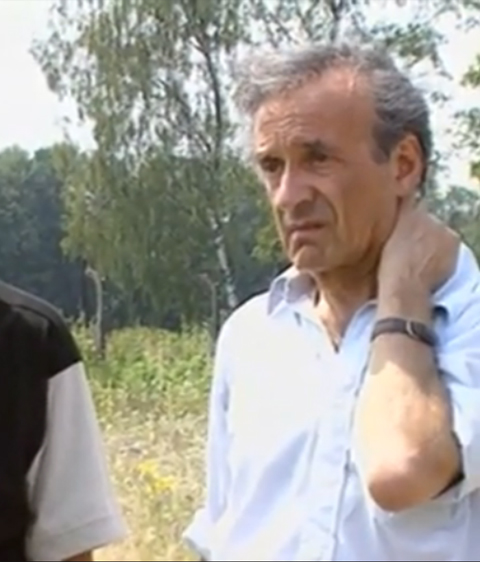 Associated Press reporter Verena Dobnik may be guilty of intentional mis-represention in an AP story published Oct. 8, 2012 in which she said she saw a tattoo on Elie Wiesel’s left forearm.
Associated Press reporter Verena Dobnik may be guilty of intentional mis-represention in an AP story published Oct. 8, 2012 in which she said she saw a tattoo on Elie Wiesel’s left forearm.
The story was carried by many news outlets, including the Washington Times, Seattle Times, Huffington Post, Salon.com, the Bend Bulletin (Oregon), The Sun Chronicle, Flagstaff Today, Deseret News , Yahoo news, The Times of Israel (and other specifically Jewish news media).
No date for the actual sit-down interview is given in the report, which is titled “Elie Wiesel survives Madoff wipeout, heart by-pass,” and was contributed to by another Associated Press writer, Randy Herschaft. This is not the first time Dobnik and Herschaft have worked together. In the news story, Dobnik, who was born in Slovenia and lives in New York, claims to have seen Wiesel’s tattoo but does not describe what she saw. She writes:
He pulls back his left jacket sleeve to reveal a Nazi death camp number tattooed on his forearm as he sits comfortably in his Manhattan office for an interview.
“Usually, I don’t show it,” he says.
One of the exceptions was a 2009 visit to the Buchenwald death camp Wiesel survived, with President Barack Obama and German Chancellor Angela Merkel.
Was this extraordinary claim checked out for accuracy by the Associated Press before running the story? In all of his 62 years in public life (since 1950) Wiesel has never exhibted publicly a tattoo on his left arm. Furthermore, there are some photographs taken over the course of the years in which his bare left arm can be clearly seen (sometimes in bright sunlight, as in the unretouched photo here taken from Wiesel’s own film about a return visit to Auschwitz) and none show any kind of mark on his arm, let alone anything that resembles an Auschwitz concentration camp number.
Where’s the excitement?
Dobnik’s claim is so surprising that it should have garnered excitement from the mainstream media, but just the opposite happened – it was totally ignored and some publications that had originally published the story may have removed it from their online news sites! For this reason, I doubt that this incident ever actually happened; I think it very likely that Verena Dobnik added it to her interview simply because she wanted to. I can’t give her motivations, which may be quite complex. But this part of her interview should have set off a red light for the AP editors, and some questions should have been asked. Not just the seven I list below, but also why she should mention it at all if no photograph proving what she says she saw accompanies the article? I do not, at this point, speculate that Wiesel drew something on his arm and then gave Dobnik a quick glance at it. It seems far more likely to me that Dobnik, as other journalists have done, just added it to her story on her own. I have to add that Wiesel’s handlers and publicity team have not killed the story – so he doesn’t disapprove of it.
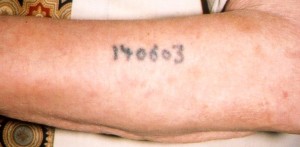 A challenge to Wiesel, Dobnik and the AP
A challenge to Wiesel, Dobnik and the AP
(At left is a detail of a photograph of the left arm of Auschwitz survivor Sam Rosenzweig.) If Wiesel is willing to show his tattoo to the reporter Dobnik, why won’t he show it to the general public and end the questions and swirling speculation about “does he or doesn’t he” have what he says he has? This kind of tease from Ms. Dobnik cannot go unanswered, especially from Elie Wiesel Cons The World where we have been asking this question for two and one-half years – since July 2010 – without ever being shown even a picture of Wiesel’s alleged tattoo. I therefore do not believe this reporter’s story and accuse her of journalistic fraud. She and Mr. Herschaft are clearly biased reporters who favor, and even specialize in, the traditional ‘holocaust’ narrative. I will register this complaint in a formal way with the Associated Press and I urge you readers to do the same. Don’t sit back and expect others to work miracles on your behalf – take action. The more the Associated Press hears about this, the better.
Contact info for the Associated Press: Call AP headquarters at 212.621.1500 or email [email protected] for general inquiries. Here is a List of AP news bureaus and correspondents. AP says they welcome feedback and comments from readers. Send an email to [email protected] and it will be forwarded to the appropriate editor or reporter. Remove any attachments, including email signatures, company logos and disclaimers, to ensure that we receive it. (Don’t attach this article, or even link to it, for best results. It should not appear to be an organized campaign from this website.)
Some questions we can fairly ask of Ms. Dobnik and the AP editors are:
- Does she know what a “Nazi death camp number” looks like? She apparently doesn’t know that Auschwitz was the only German concentration camp that tattooed prisoners, so there is no such thing as a “death camp number,” only an Auschwitz camp number.
- Can she describe what this number tattooed on Wiesel’s arm looked like? And why didn’t she? Did she get a long enough or close enough look at it to be sure of what she “saw?”
- Why would the Nazis tattoo prisoners in a “death camp” who were presumably scheduled for death? If they were not all scheduled for death, why call it a “death camp number?”
- Why does she and the AP continue to call Auschwitz a “death camp” when so many survived, along with their tattoos?
- How does she know that Wiesel showed his tattoo to President Obama and Chancellor Merkel in 2009 during a visit to Buchenwald? The implication is that she had to learn it from him, during the interview, but she doesn’t include this in her report so we don’t know.
- Buchenwald is not listed as one of the supposed “death camps” (they are all outside of Germany proper), so why is Dobnik allowed to call Buchenwald a “death camp.”
- How many other mistakes has this AP reporter made in her dire ignorance of what she is writing about?
9 Comments
Category Featured | Tags: Tags: Associated Press, Auschwitz, death camp, Elie Wiesel, Randy Herschaft, Verena Dobnik,
Social Networks: Facebook, Twitter, Google Bookmarks, del.icio.us, StumbleUpon, Digg, Reddit, Posterous.
Thursday, September 27th, 2012
This article is courtesy of Jett Rucker and Smith’s Report, where it appears in the current issue.
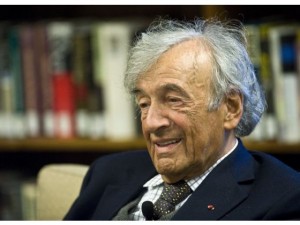 Since Elie Wiesel is “the world’s most famous Holocaust survivor,” I asked Mr. Rucker if I could post his article here. It does an effective job of putting the term “holocaust survivor” into a more realistic context – one that includes all “survivors.” I have added the sub-headings and pictures, and done very slight editing (removing some phrases in parentheses) for ease of reading.
Since Elie Wiesel is “the world’s most famous Holocaust survivor,” I asked Mr. Rucker if I could post his article here. It does an effective job of putting the term “holocaust survivor” into a more realistic context – one that includes all “survivors.” I have added the sub-headings and pictures, and done very slight editing (removing some phrases in parentheses) for ease of reading.
Of course, my position remains that it is doubtful Elie Wiesel was in the camps at all. Thus, his “survivor guilt” might be even greater than if he were, and survived. Can that explain his lifelong campaign on behalf of keeping “Memory” alive of what occurred, both fictitious and real? Some might think so, but perhaps a better explanation is plain old opportunism. The many favors and privileges Wiesel has obtained throughout his lifetime are based on his “survivorship;” keep that in mind as you read the following.~cy [Image: Ye olde survivor Elie Wiesel has lived the good life, as his contented face reveals.]
Survivor Guilt
by Jett Rucker
“Survivor guilt” has come into popular usage as an irrational complex on the part of people who are among a very small number of people who, by sheer happenstance, have emerged alive from a disaster that took the lives of many others who seem to have deserved no more (or less) to have survived than they (the survivors) did. Occasionally, for example, a plane crash occurs from which one, or perhaps two, victims emerge relatively unscathed, while all their fellows perished in the catastrophe. The complex plagues them for years after the event, in some cases.
Now and then, though, some sort of more-genuine guilt may seem to attach to the fact of survivorship, as in the case of the (surviving) members of a Uruguayan rugby team who committed (and admitted to) cannibalism in the process of surviving two months on a remote peak in the Andes where their plane had crashed in 1972. The surviving cannibals were absolved of their “sin” by the Pope, whom both the perpetrators and, presumably, the victims acknowledged as their spiritual shepherd.
A stronger presumption of actual guilt on the part of survivors might attach, say, to adult male survivors of the Titanic sinking in 1912, as they might be suspected of having violated or otherwise evaded the famous stricture supposedly invoked at the time, “Women and children first.” Some male passengers apparently did that, while others are thought to have boarded life boats that were about to depart the sinking vessel with empty seats in them.
The dead have not been heard from …
And then, there are those long-term situations imposed by a hostile group of others, in which a potential for treachery, betrayal, collaboration, or even fouler play might enter the picture. In the annals of human conflict, undoubtedly war provides the greatest number of these situations, especially if they are rated by numbers of either: (a) dead victims, who cannot testify as to what occurred; or (b) survivors, who perforce provide the only narratives available as to what occurred. Be it noted: neither group, not individually nor collectively, is in a position to even understand all of what did happen, quite aside from what might have happened had anyone acted differently from the way they did.
War veterans are no doubt the most-numerous of the groups that fit the description above, including both those who survived and those who, not surviving, never gained the exalted status of veterans. I often wonder how the glories of past victories (and defeats) might be perhaps somewhat dimmed if the voices of the dead might be heard on the occasions when the glories are celebrated among the survivors and their putative beneficiaries.
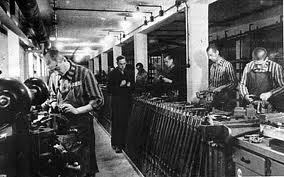 War Industry Workers: “survivors” or veterans?
War Industry Workers: “survivors” or veterans?
A very special, if demographically dwindling, group remains in our midst who command, and lately often claim, reverence that is not accorded even to veterans of this (or other) nation’s wars. These are those who claim to have been forced by the National Socialist regime that governed Germany from 1933 to 1945 to leave their homes and properties in Germany for resettlement or labor camps to the east of Germany because they were Jews, as well as those Jews resident in countries east of Germany who were dragooned into service in Germany’s war-industry plants such as those in Birkenau, Dora-Mittelbau, and over a thousand other locations: “Holocaust survivors,” as they style themselves.
Such persons (the genuine ones among the many claiming such status with no basis whatsoever in truth) are survivors, if at all, only in the sense that anyone residing in Germany or Austria by the time World War II reached its catastrophic end was a survivor. What they survived was not forced labor (to which many were indeed subjected), but the blanket devastation wreaked by Allied bombers upon the domiciles of the entire populace of their “targets.” Insofar as their survival involved their conscription into forced labor in war-industry factories, such fortunates may as well be designated “veterans” as their less-fortunate predecessors were conscripted to go to the front, there to confront the irresistible onslaught of Soviet manpower and American productivity.
Be all this as it may, all an elderly Jew in America with any sort of claim to European origins need do to command instant respect and credulity among those around him or her, is to invoke the sacred appellation, “Holocaust Survivor.” Once this is done, silence reigns all around, and rapt attention is reflexively granted by all those in attendance, they all having long since been conditioned to render such obeisances upon hearing the Pavlovian Bell.
Jewess Anna Breslaw questions the innocence of “Holocaust survivors”
 An intrepid, if possibly naïve, American Jewess of unwonted analytic disposition, Anna Breslaw, writing for the Tablet, ventured the irrefutable speculation that some of the few genuine “Holocaust survivors” among those many claiming the vaunted status might, indeed, have survived the parlous times they undoubtedly went through, by way of guile, or even treachery, in a few cases.* She did not trouble her argument with particulars as to how her co-religionists might have collaborated, contrived, betrayed, or otherwise arranged for themselves the favored treatment that enabled them to “survive,” but the force of her argument was sufficient to rouse into action none other than that Centurion of the Sanctity of the Holocaust Mythology, Jeffrey Goldberg of the Atlantic Magazine. He styled Breslaw’s impeccable logic as “ghastly.”
An intrepid, if possibly naïve, American Jewess of unwonted analytic disposition, Anna Breslaw, writing for the Tablet, ventured the irrefutable speculation that some of the few genuine “Holocaust survivors” among those many claiming the vaunted status might, indeed, have survived the parlous times they undoubtedly went through, by way of guile, or even treachery, in a few cases.* She did not trouble her argument with particulars as to how her co-religionists might have collaborated, contrived, betrayed, or otherwise arranged for themselves the favored treatment that enabled them to “survive,” but the force of her argument was sufficient to rouse into action none other than that Centurion of the Sanctity of the Holocaust Mythology, Jeffrey Goldberg of the Atlantic Magazine. He styled Breslaw’s impeccable logic as “ghastly.”
Goldberg advanced the view of what he hopes might still be the dominant view of Jewish and Jewish-conditioned readers of his widely circulated platform. Maybe it is, and maybe the Tablet has got the ear (mind, heart) of thoughtful readers of both (or all) publications. Goldberg’s time-worn imprecations bear inspection, as do Breslaw’s rather more-nuanced comments, made, be it noted, in a context rather remote from the ones implied in Goldberg’s tirade.
Can real “Holocaust survivors” really be innocent?
Breslaw’s well-considered cautions arrive on the American scene at a critical time when real “Holocaust Survivors” have faded from the scene that they never had the temerity to dominate in the first place, but self-qualified “survivors” have taken their place to affect shock and affront at such “disparagements” as Breslaw offers. Real “Holocaust survivors,” keenly aware from genuine experience what moral ambiguity attends the status to which they could lay claim, have always remained reticent in proclaiming the particulars of their experiences, and acts. Those many who lack this experience, but claim it by implication, let on as though they were blameless both in terms of their incarceration in the first place, but further—and this is the stretch—as to their deportment while actually incarcerated.
The act can be pulled off only by those quite innocent of the genuine experience. Those who affect utter innocence in the fates they claim may be dismissed as being innocent not only of guilt, but also of the experiences they claim to have.
As for Goldberg, and his magazine, we may consign them to a category reserved for those liars who propose to benefit from the success that may be enjoyed by still other liars.
*Of particular interest to us is this passage by Breslaw:
… in grade school I received the de rigueur exposure to the horror—visiting geriatric men and women with numbers tattooed on their arms, completing assigned reading like The Diary of Anne Frank and Night. But the more information I received, the less sympathy the survivors elicited from me. Each time we clapped for the old Hungarian lady who spoke about Dachau, each time Elie Wiesel threw another anonymous anecdote of betrayal onto a page, I eyed it askance, thinking What did you do that you’re not talking about? I had the gut instinct that these were villains masquerading as victims who, solely by virtue of surviving (very likely by any means necessary), felt that they had earned the right to be heroes, their basic, animal self-interest dressed up with glorified phrases like “triumph of the human spirit.”

2 Comments
Category Featured | Tags: Tags: "Holocaust survivors", Anna Breslaw, Elie Wiesel, Jeffrey Goldberg, Tablet Magazine,
Social Networks: Facebook, Twitter, Google Bookmarks, del.icio.us, StumbleUpon, Digg, Reddit, Posterous.
Sunday, August 5th, 2012
By furtherglory
(First published at Scrapbookpages Blog on August 2, 2012)
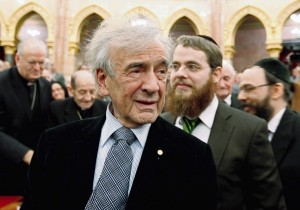 Yesterday the online Chicago Tribune had an article which reported that “In recognition of [Elie] Wiesel’s vast contributions to the art of the printed word, which includes more than 50 works of fiction and nonfiction, he has been named winner of the 2012 Chicago Tribune Literary Prize.”
Yesterday the online Chicago Tribune had an article which reported that “In recognition of [Elie] Wiesel’s vast contributions to the art of the printed word, which includes more than 50 works of fiction and nonfiction, he has been named winner of the 2012 Chicago Tribune Literary Prize.”
[Photo of Wiesel at left is from December 2009 in Budapest, Hungary. ]
After reading this article, I immediately checked out Carolyn Yeager’s website Elie Wiesel Cons the World to see what she has to say about this new honor for Elie Wiesel. I found a video which explains the whole story of Elie Wiesel in great detail. The video starts out with the sound of an old fashioned typewriter as the keys hit the paper, typing out the URL of the website. I love it!
The sound of the typewriter keys brought back a flood of memories; I was alive during World War II and I saw the news reels of the liberation of Bergen-Belsen and read about the liberation of Dachau. Yet I didn’t get interested in the Holocaust until many years later. My lack of interest in the Holocaust was nothing unusual, as the video on Yeager’s website points out.
The article in the Chicago Tribune also points out that there was very little interest in the Holocaust as late as 1960 when Elie Wiesel’s book Night was first published in English.
This quote is from the Chicago Tribune:
After the war, [Elie Wiesel] worked as a journalist in France for Yiddish and French publications. The noted French writer and Nobel laureate Francois Mauriac urged Wiesel to write his Holocaust memoir, and Mauriac “went from one publisher to another,” said Wiesel, to persuade them to take on Wiesel’s book.
At first, “Night” generated little interest, and the English-language publication in 1960 “sold 5,000 copies in three years,” Wiesel said. “And the same thing, by the way, in France — everywhere.”
Why was the world slow to recognize the book’s value?
“Maybe it needed — the world itself needed maybe a whole generation for readers to realize that they must know something more” about the Holocaust, Wiesel said.
As a person who was alive and well between 1945 and 1960, I can tell you why no one was interested in the Holocaust during that period. The years after World War II were the best of times. During the 1950s, everyone was extremely happy to be living during peace time; no one wanted to re-live the war. I was writing and selling magazine articles during the 1950s, but not stories about the Nazi concentration camps, which would not have been of interest to very many people at that time. There were thousands of Holocaust survivors in American during those years, but they were keeping their mouths shut and hiding their tattoos.
I lived in Germany for two years after World War II, but I didn’t bother to go to see the former Dachau camp. When I went back to Germany for the first time in 1995, I didn’t go to see the Dachau Memorial Site. The Holocaust did not become as popular as it is now until many years later. If only I had anticipated the Holocaust mania, I could have written a novel about Auschwitz and Buchenwald and become a millionaire. Many people have urged me to write a fake Holocaust memoir, but I think it is too late for me; there are too many fake memoirs on the market.
I was one of the first to put the information on the Internet that Elie Wiesel could not have been in the famous photo taken in Barrack 56 in Buchenwald on April 16, 1945 because, by his own account as written in his book Night, he was in the camp hospital on that date. You can read that page on my website, which I updated 3 years ago, here.
1 Comment
Category Featured | Tags: Tags: Chicago Tribune, Elie Wiesel, Night, Scrapbookpages Blog,
Social Networks: Facebook, Twitter, Google Bookmarks, del.icio.us, StumbleUpon, Digg, Reddit, Posterous.
Tuesday, June 19th, 2012
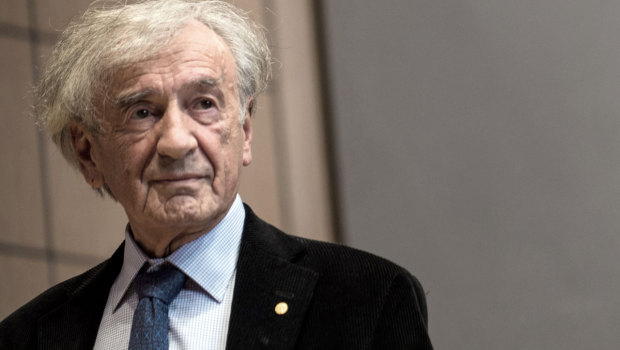
Elie Wiesel in 2012
By Carolyn Yeager (edited on June 21st)
Elie Wiesel is making news again by repudiating a Hungarian Government award he received in 2004. By this gesture, he apparently hopes to intimidate independent nation-states to take into consideration Jewish Power – Holocaust-Power – in every decision they make. Wiesel also likes to gain public attention for what he alleges to be the crimes of the Nazis and their collaborators.
The award Wiesel is returning (or is he? I cannot confirm that) is the Republic of Hungary’s Order of Merit, Grand Cross presented to him by president Ferenc Madl in 2004. Let’s hope he never gets it back.
Wiesel said last week that he was “outraged” that Hungarian House Speaker Laszlo Kover participated, together with Hungarian Secretary of State for Culture Geza Szocs and far-right Jobbik party leader Gabor Vona, in a re-burial ceremony in Romania honoring author Jozsef Nyiro, who was a member of the Arrow Cross Parliament during the 1930′s.
“It’s just too close to home,” Wiesel told an Associated Press interviewer. In a letter to Kover, he wrote “It is with profound dismay and indignation that I learned of your participation” with Szocs and Vona in a ceremony honoring “a fascist ideologue of the Horthy and Szalasi regimes”.
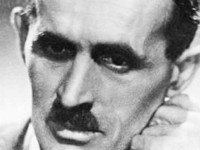
Background on Nyiro
From The failed reburial of József Nyirő in Transylvania, May 30, 2012 in the Buda Post:
József Nyirő was a Catholic priest who became a writer after Transylvania was annexed to Romania in 1920. His works, according to the government’s new draft curricula, should in future be taught in Hungarian high schools. In 1941, after the re-annexation of Transylvania to Hungary, Nyirő became a Member of Parliament in Hungary and as such went into exile in 1945. He died in Spain in 1953, and his last wish was to be buried in his homeland. At the initiative of the Hungarian Civic Party (MPP), a small Hungarian ethnic party in Transylvania, the Office of the Hungarian Parliament initiated his reburial. The new Romanian government, however, regards Nyirő as a Hungarian irredentist writer. Nyirő’s reburial, which was scheduled for Sunday (28 May) was cancelled after the Romanian authorities withdrew permission, claiming that the document carried the wrong registration number. Romanian PM Victor Ponta called the reburial a provocation.
A commemoration event was held instead of the reburial. What Elie Wiesel objects to is that three Hungarian officials attended the commemoration. Wiesel wants all-out condemnation of anyone and everyone who is painted as a “far right National-Socialist, fascist or antisemite.”
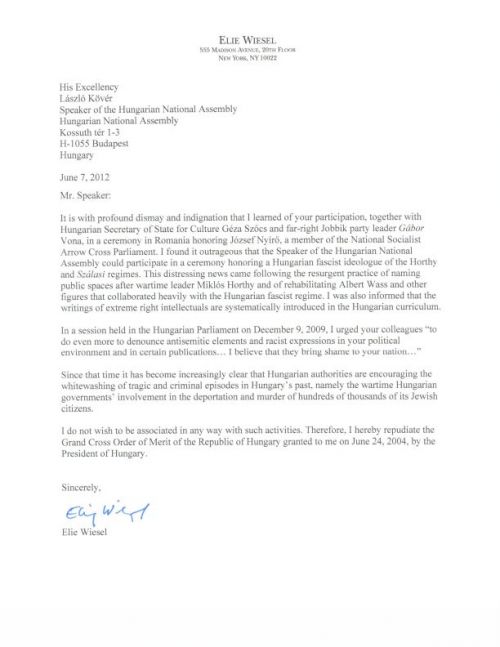
Here is the letter that Wiesel wrote to the Speaker of the Hungarian National Assembly. Sorry it is such poor quality. He writes in paragraph two that in 2009 he urged members of the National Assembly “to do even more to denounce antisemitic elements and racist expressions in your political environment and in certain publications … I believe they bring shame to your nation.”
He writes that since that time it has become worse, that Hungarian authorities are “whitewashing” Hungary’s criminal past.
Finally, “I do not wish to be associated in any way with such activities. Therefore, I hereby repudiate the Grand Cross Order of Merit … given to me on June 24, 2004 by the President of Hungary. He doesn’t say he is returning it, does he. But it is so reminiscent of his statements that he does not want to be in the same room with a “holocaust denier.” He clearly feels he’s being contaminated by those whose views are opposite to his.
And there is the famous Wiesel signature which doesn’t resemble at all the signature on the U.S. Military Questionaire signed by Lázár Wiesel in 1945. It was I who first thought to compare the signatures and brought it to light in September 2010.
Much ado about what?
Jewish insanity is behind the dis-allowance of a man’s cremated remains to be buried in the land in which he was born, and which he loved. Josef Nyiro was born in Hungarian-populated Transylvania, just as Elie Wiesel was. After it was given to Romania in 1920, it remained majority Hungarian. After 1945, Transylvania was handed back over to Romania, but is still populated by mostly Hungarians. Josef Nyiro was of Hungarian ethnicity; Elie Wiesel is of Jewish ethnicity … neither Hungarian nor Romanian. Yet Elie Wiesel would surely have been in favor of not allowing Josef Nyiro’s remains to be buried in his own (and only) homeland (where Elie Wiesel does not want to be buried — he may want to be buried in Israel), while he definitely wants to prevent Hungarian nationals from honoring this man.
Does Elie Wiesel, the Jew whose own spiritual homeland is Israel, want to determine for Hungarians and Romanians what they can and cannot do in their homelands? Yes. Does this make any sense? Only to someone like Elie Wiesel.
17 Comments
Category Featured | Tags: Tags: Elie Wiesel, Josef Nyiro, Laszlo Kover, Republic of Hungary Order of Merit, Romania,
Social Networks: Facebook, Twitter, Google Bookmarks, del.icio.us, StumbleUpon, Digg, Reddit, Posterous.
Saturday, June 9th, 2012
10 Comments
Category Featured | Tags: Tags: Carolyn Yeager, Elie Wiesel, Elie Wiesel Cons The World,
Social Networks: Facebook, Twitter, Google Bookmarks, del.icio.us, StumbleUpon, Digg, Reddit, Posterous.
Thursday, May 31st, 2012
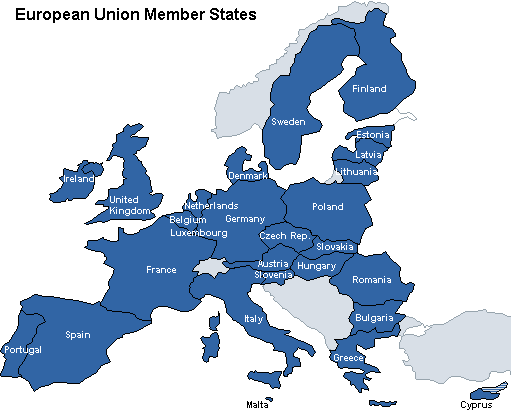 Europe (above) should be wide open to all comers, according to Elie Wiesel, EGAM (European Grassroots Antiracist Movement) and SOS-Racisme.org.
Europe (above) should be wide open to all comers, according to Elie Wiesel, EGAM (European Grassroots Antiracist Movement) and SOS-Racisme.org.
By Carolyn Yeager
(last edited on June 1st)
Elie Wiesel wants you to sign a petition that proclaims “We are all Greek Jews. ” It in essence will mean that you approve that Greek voters (and voters in every other European nation) must comply with the wishes of the Jewish community in their nation when it comes to their political choices. This is such insanity that the world media are not even carrying the story. The Guardian was chosen to publish the petition as a news story, but it has not spread very far.
Elie Wiesel, however, is one of the original signatories, lending whatever prestige he may still possess to the misbegotten venture. The other signers are mostly Jewish, with a possible smattering of water-carriers and communists. The sponsors include two antiracist organizations: EGAM and SOS Racisme. What do they want? They want to destroy Europe as a white homeland. Can anyone really think this is a good idea?
Voice of conscience
Organized Jewry presents itself as the voice of conscience of the world. This has long been a favored method of control and, though there is no basis for it, many white European peoples, because of the constant media barrage portraying Jews as “wise and carriers of the West’s oldest religion,” seem to fall for it. The Jew-controlled mass media is the new “Holy Scripture” that gives us our modern morality of Tolerance as the highest virture and Equality as the highest law.
The main intention of Elie Wiesel and the other signatories is to enforce “The Holocaust” as the world’s religion for the goyim … as they term all non-Jews. For the same reasons they seek to make the world accept Jerusalem as the supreme seat of international justice, from whence the final decisions on all matters—for which there will be no appeal—will flow. We are to view the world through Jewish eyes and only through Jewish eyes. The very first paragraph of the petition tells us this.
The neo-Nazi party Golden Dawn entered the Greek parliament this month. With its swastika-inspired emblem, Hitlerian salute, reference to Mein Kampf, antisemitic and racist ideology, Holocaust denial, violence against migrants, threats against journalists and personality cult, the party is the lineal heir of the German national-socialist party that led Europe and the world into chaos and bloodshed.
Who else but Jews would write this? But it is incorrect — it was not the German National-Socialist party that led Europe and the world into chaos and bloodshed. It was in actuality World Jewry! The petition then goes on to add Latvia, Austria, and Hungary to Greece for the crime of “Third Reich nostalgia,” simply because a segment of their populations voted for anti-immigration parties considered to be on the “right.” Finally, it accuses Geert Wilders Freedom Party in The Netherlands of promoting “race inequality” because it is against so many Muslims in the country changing the culture from Dutch to middle-eastern.
The petition signatories hate nationalism and favor regional unions (like the EU) and an over-arching world government because they think they have a better chance of manipulating the latter to their purposes. They use the word “terrifying” to describe trends toward nationalism, implying that Greek Jews (a tiny minority in Greece who make far more noise than their numbers warrant) are in danger of extermination!
We refuse to accept that on our continent, Jewish, immigrant, Muslim, Roma or black people might fear for their lives because of who they are. We invite all citizens, political parties, unions, civil society, intellectuals and artists to fight the extreme right by promoting and bringing to life the European dream. We must always remember that this dream was built on the ruins of Nazism. We must never forget about the Shoah. Our dream is of a continent free from racism and antisemitism. It is the project of a society based on “togetherness” – beyond boundaries.
Incredible assumptions. Their continent? Europe is not the Jews’ homeland, nor is it the homeland of Muslim, Roma or black people. It is the homeland of white Caucasian, Indo-Aryan people. It is these white Caucasian people who are now fearing for their lives! Europe does have boundaries, and those boundaries are important. It is clear that these signatories, which include Elie Wiesel, want to exert their own very un-European ideas on Europe. When Europeans begin to resist this alien takeover and the imposition of the “Holocaust” religion, these Jews naturally get very nervous. They over-react, as they’re doing now.
Recommended Dogmas
They go so far as to propose two shockingly blatant “dogmas” for Europeans — as if the World International Court in Jerusalem were already a reality.
- Refute austerity (a slam at Germany), because it puts the bankers (Jewish capitalism) out of their profits from eternally increasing debt (a ponzi scheme).
- Refute the anti-immigration “lockdown” of Europe’s frontiers, because the social welfare system requires constant immigration to sustain itself.
They insist on democracy, social justice and the promotion of equality. They mean by this that blacks, gypsies (who are not indigenous to Europe but came from India), Asians, Arabs and Jews must be considered equal to the national population simply by putting their feet on that national soil. They must be given social equality, meaning special financial and other assistance that will afford them a comparable lifestyle to the working native population. In this way, the illusion can be created that everyone is equal. See Germans to Learn Turkish … instead of Turks learning German, for the shape of things to come if Elie Wiesel has his way.
Why not “We are all Palestinians now”
One naturally has the thought: Why aren’t these Jewish petitioners compiling something to send to Israel titled “We are all Palestinians now.” Why isn’t equality desirable in Israel? The inequality in Palestine under Jewish rule is far, far, far worse than anything found in Europe. Ditto the anti-immigration feeling. What we have here is the same old hypocrisy that Elie Wiesel has been exhibiting his entire life.
These petition signers know that forced equality is unnatural and will weaken, even sicken, the host population. So for them, Europe belongs to everyone. But Israel belongs to the Jews.
Don’t sign the petition, and in fact mock and ridicule anyone who does. They deserve it.
15 Comments
Category Featured | Tags: Tags: Elie Wiesel, Europe, Greek Jews, New Dawn Party,
Social Networks: Facebook, Twitter, Google Bookmarks, del.icio.us, StumbleUpon, Digg, Reddit, Posterous.
 Is KSU President Lefton Jewish?
Is KSU President Lefton Jewish? Copying images from this website and getting blow-ups made to paste onto posters seems to me a doable thing. It’s best to start organizing now, contacting others you know in Ohio and especially the Kent, Ohio area. I know Ohio is well-populated with men and women who consider themselves part of the Truth Movement. Heck, even Gordon Duff lives in Ohio and he fashions himself on VT as some kind of “holocaust revisionist.” He should act the part and get out there and challenge Elie Wiesel’s version of history. And remember, you don’t have to be a “holocaust denier” to object to the false testimony of Elie Wiesel! Don’t let anyone get away with labeling you with that. Be brave, and spend some of your valuable time for the truth. This may be the last opportunity you’ll have to protest Elie Wiesel in person before death turns him into an eternal martyr and saint.
Copying images from this website and getting blow-ups made to paste onto posters seems to me a doable thing. It’s best to start organizing now, contacting others you know in Ohio and especially the Kent, Ohio area. I know Ohio is well-populated with men and women who consider themselves part of the Truth Movement. Heck, even Gordon Duff lives in Ohio and he fashions himself on VT as some kind of “holocaust revisionist.” He should act the part and get out there and challenge Elie Wiesel’s version of history. And remember, you don’t have to be a “holocaust denier” to object to the false testimony of Elie Wiesel! Don’t let anyone get away with labeling you with that. Be brave, and spend some of your valuable time for the truth. This may be the last opportunity you’ll have to protest Elie Wiesel in person before death turns him into an eternal martyr and saint.




























